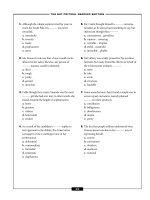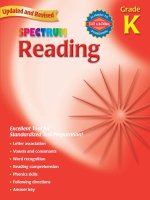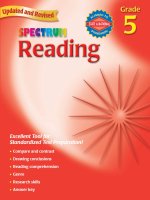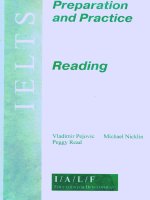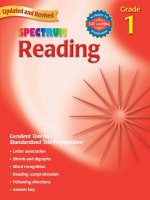spectrum reading grade 1
Bạn đang xem bản rút gọn của tài liệu. Xem và tải ngay bản đầy đủ của tài liệu tại đây (13.84 MB, 163 trang )
Excellent Tool for
Standardized Test Preparation!
•
Letter association
•
Blends and digraphs
•
Word recognition
•
Reading comprehension
•
Following directions
•
Answer key
READING
Grade 1
Visit our Web site at:
www.FrankSchaffer.com
EAN
ISBN 0-7696-3861-9
UPC
U.S. $9.95
Can. $12.95
Making Children More Successful!
Spectrum, our best-selling workbook series, provides quality educational activities
that meet students’ needs for learning achievement and success.
Spectrum Reading Grade 1 helps young learners improve and strengthen their fiction
and nonfiction reading skills, such as:
• Letter association • Reading comprehension
• Blends and digraphs • Following directions
• Word recognition
Reading (Grades K–6)
Math (Grades K–8)
Spelling (Grades 1–6)
Writing (Grades 1–8)
Language Arts (Grades 2–6)
V
ocabulary (Grades 3–6)
T
est Prep (Grades 1–8)
Test Practice (Grades 1—8)
Geography (Grades 3–6)
Phonic
s (Grades K–3)
Word Study and Phonics (Grades 4–6)
Science Test Prep (Grades 3–8)
Basic Concepts and Skills (Preschool)
L
earning Letters (Preschool)
Math Readiness (Preschool)
Reading
Grade 1
Spectrum is an imprint of Frank Schaffer Publications.
Printed in the United States of
America. All rights reserved. Except as permitted under the United States Copyright Act, no
part of this publication may be reproduced or distributed in any form or by any means, or stored in a database or retrieval
system, without prior written permission from the publisher, unless otherwise indicated. Frank Schaffer Publications is an
imprint of School Specialty Publishing. Copyright
©
2007 School Specialty Publishing.
Send all inquiries to:
Frank Schaffer Publications
8720 Orion Place
Columbus, Ohio 43240-211
1
Spectrum Reading—grade 1
ISBN 0-7696-3861-9
1 2 3 4 5 6 POH 11 10 09 08 07 06
Frank Schaffer Publications
®
Spectrum Reading Grade 1 Index of Skills
ii
Index of Skills
Reading Grade 1
Reading Comprehension
Comprehension Skills
Following directions—All exercise pages
Determining the main idea—51, 53, 55, 57,
59, 61, 63, 65, 67, 69, 71, 73, 75, 77, 79
Facts and details—55, 57, 59, 61, 63, 65,
67, 69, 71, 73, 75, 77, 79, 89, 91,93, 95, 97,
99, 101, 103, 105, 107, 109, 111, 113, 115,
117, 119, 121, 123, 125, 127, 129, 131
Predicting outcomes—51, 53, 55, 57, 59, 61,
63, 65, 67, 69, 71, 73, 75, 77, 79
Sequencing events—3, 5, 7,11, 25, 81
Classifying objects—15, 21, 49
Using the pictures 13, 21, 29, 31, 84
Phonics
Letters and Sounds
Letter study: 51, 53, 55, 57, 59, 61, 63, 65,
67, 69, 71, 73, 75, 77, 79
Blends—15, 17, 19, 23, 25, 27, 33, 51, 53,
55, 57, 80, 82, 83
Digraphs:
Ch–29 th–33 Ch, th, sh, wh–37
Sh–31 wh–35
Ending consonants—15, 17, 19, 21, 23, 25,
27, 82
Beginning consonants—3, 5, 7, 9, 11, 13
Long vowels—29, 31, 33, 35, 37, 39, 41, 43,
45, 47, 49
Short vowels—35, 37, 39, 41, 43, 45, 47, 49
Knowing the Words
Creating rhymes—9, 17, 27, 48, 51, 53, 55,
57, 63, 65, 77, 79, 87, 89, 91, 95, 97, 99,
101, 103, 105, 107, 109, 111, 113, 115, 117,
119, 121, 123, 125, 127, 129, 131
Sight word recognition—
All lessons
Word recognition—All lessons
Choosing the correct word—61, 63, 65, 67,
73, 79, 81, 87, 89, 91, 93, 95, 97, 99, 101,
103, 105, 107, 109, 111, 123, 125, 132, 133,
137
Missing letters—51, 53, 55, 57, 59, 61, 69,
71, 75, 77, 113, 115, 135, 136
Learning to Study
Following directions—All activity pages
Note: If passages or directions are too
difficult for the student, a teacher or parent
should read them aloud to the student.
Numerals indicate the exercise pages on which these skills appear.
Spectrum Reading Grade 1 Table of Contents
1
Fiction Stories:
Little Duck
Little Duck . . . . . . . . . . . . . . . . . . . . . . . . . . 2
Mama Duck . . . . . . . . . . . . . . . . . . . . . . . . . 4
Wiggle-Waddle. . . . . . . . . . . . . . . . . . . . . . . 6
Dinnertime . . . . . . . . . . . . . . . . . . . . . . . . . . 8
Fish Is Not Dinner . . . . . . . . . . . . . . . . . . . 10
Make Way for Ducklings . . . . . . . . . . . . . . 12
A Feast. . . . . . . . . . . . . . . . . . . . . . . . . . . . 14
Bread Crumbs . . . . . . . . . . . . . . . . . . . . . . 16
Little Duckling?. . . . . . . . . . . . . . . . . . . . . . 18
Quack, Quack, Quack . . . . . . . . . . . . . . . . 20
Brrr! . . . . . . . . . . . . . . . . . . . . . . . . . . . . . . 22
New Friend. . . . . . . . . . . . . . . . . . . . . . . . . 24
Snails Away!. . . . . . . . . . . . . . . . . . . . . . . . 26
Little Duck and Matilda Go to the Farm. . . 28
Duck Soup . . . . . . . . . . . . . . . . . . . . . . . . . 30
Little Duck Dives . . . . . . . . . . . . . . . . . . . . 32
What to Do With a Penny . . . . . . . . . . . . . 34
Make a W
ish, Little Duck . . . . . . . . . . . . . . 36
Little Duck Is Scared . . . . . . . . . . . . . . . . . 38
Little Duck Tries . . . . . . . . . . . . . . . . . . . . . 40
Little Duck and Matilda Fly . . . . . . . . . . . . 42
A Cloud . . . . . . . . . . . . . . . . . . . . . . . . . . . 44
Little Duck Soars . . . . . . . . . . . . . . . . . . . . 46
Carolyn Dreams of a Pet
Carolyn Dreams of a Pet . . . . . . . . . . . . . . 50
Carolyn Talks to Her Mom . . . . . . . . . . . . . 52
Time for a Pet . . . . . . . . . . . . . . . . . . . . . . 54
Knock, Knock . . . . . . . . . . . . . . . . . . . . . . . 56
I Promise . . . . . . . . . . . . . . . . . . . . . . . . . . 58
Yes or No? . . . . . . . . . . . . . . . . . . . . . . . . . 60
A Real Pet . . . . . . . . . . . . . . . . . . . . . . . . . 62
Today a Pet . . . . . . . . . . . . . . . . . . . . . . . . 64
Two Good Things. . . . . . . . . . . . . . . . . . . . 66
The Pound . . . . . . . . . . . . . . . . . . . . . . . . . 68
Carolyn Is Sad . . . . . . . . . . . . . . . . . . . . . . 70
Promise Jones . . . . . . . . . . . . . . . . . . . . . . 72
A New Kitten . . . . . . . . . . . . . . . . . . . . . . . 74
A Gift . . . . . . . . . . . . . . . . . . . . . . . . . . . . . 76
Promise Jones Comes Home . . . . . . . . . . 78
Nonfiction: Due to content these pages
have more advanced vocabulary. These
passages may need to be read with a
teacher or parent guide depending on
child’s reading level.
Alaska . . . . . . . . . . . . . . . . . . . . . . . . . . . . 86
New Mexico . . . . . . . . . . . . . . . . . . . . . . . . 88
Oregon . . . . . . . . . . . . . . . . . . . . . . . . . . . . 90
Rhode Island . . . . . . . . . . . . . . . . . . . . . . . 92
Vermont . . . . . . . . . . . . . . . . . . . . . . . . . . . 94
Kentucky . . . . . . . . . . . . . . . . . . . . . . . . . . 96
Connecticut . . . . . . . . . . . . . . . . . . . . . . . . 98
New Hampshire . . . . . . . . . . . . . . . . . . . . 100
Wisconsin. . . . . . . . . . . . . . . . . . . . . . . . . 102
Montana . . . . . . . . . . . . . . . . . . . . . . . . . . 104
Nevada. . . . . . . . . . . . . . . . . . . . . . . . . . . 106
Texas . . . . . . . . . . . . . . . . . . . . . . . . . . . . 108
Hawaii
. . . . . . . . . . . . . . . . . . . . . . . . . . . . 110
Maryland. . . . . . . . . . . . . . . . . . . . . . . . . . 112
California . . . . . . . . . . . . . . . . . . . . . . . . . 114
Florida . . . . . . . . . . . . . . . . . . . . . . . . . . . 116
New
York . . . . . . . . . . . . . . . . . . . . . . . . . 118
Pennsylvania . . . . . . . . . . . . . . . . . . . . . . 120
South Dakota . . . . . . . . . . . . . . . . . . . . . . 122
Virginia . . . . . . . . . . . . . . . . . . . . . . . . . . . 124
Minnesota . . . . . . . . . . . . . . . . . . . . . . . . 126
Colorado . . . . . . . . . . . . . . . . . . . . . . . . . 128
Arizona. . . . . . . . . . . . . . . . . . . . . . . . . . . 130
Answer Key . . . . . . . . . . . . . . . . . . . . . . 138
Table of Contents
What is that sound?
What do you think Mama Duck hears?
Something is saying,
“Quack, Quack!”
What do you think is making that sound?
That’s a funny looking foot!
Whose foot do you think that belongs to?
Hey, it’s Little Duck!
How do you think Little Duck feels?
Little Duck
2
Spectrum Reading Grade 1
Picture Interpretation and Reading (for all stories): Introduce students to Little Duck, a sweet duckling who is the focus of the following
stories. Suggest that the students look at the pictures and talk about what is happening. Have the students relate what they see to their own
lives and experiences. Be aware of the vocabulary levels and needs of the group. Key words may be reinforced or developed by writing them
on the board as each picture/picture scenario is discussed. First, have students read the story by themselves silently. Help students with any
unfamiliar words. Next, have students read the story orally
. Discussion questions have been provided to serve as a discussion guide.
Spectrum Reading Grade 1
3
Name ________________________________________
Beautiful Beginnings
2.
________ ________ ________
1.
________ ________ ________
3.
________ ________ ________
Directions:
Beginning Consonants (1-2):
Ask students to say each picture aloud and listen to the beginning sound. They then should write the beginning
letter on the line below the picture.
Sequence (3): Have students look at all the pictures. Ask them to write 1 below the event that would happen first, 2 below the event that would
happen second, and 3 below the event that would happen third.
Mama Duck kisses Little Duck
on the head.“Hello, Little Duck,”
she says.
Why does Mama Duck kiss Little Duck?
“Are you hungry, Little Duck?”
asks Mama Duck.
Does Little Duck look hungry?
Little Duck shakes his head up
and down. Little Duck is hungry.
What does it mean when you shake your head
up and down?
Mama Duck gives Little Duck
some corn to eat.
What do you like to eat?
Mama Duck
4
Spectrum Reading Grade 1
Spectrum Reading Grade 1
5
Name ________________________________________
Beautiful Beginnings
2.
________ ________ ________
1.
________ ________ ________
3.
________ ________ ________
Directions:
Beginning Consonants (1-2):
Ask students to say each picture aloud and listen to the beginning sound. They then should write the beginning
letter on the line below the picture.
Sequence (3): Have students look at all the pictures. Ask them to write 1 below the event that would happen first, 2 below the event that would
happen second, and 3 below the event that would happen third.
Spectrum Reading Grade 1
Wiggle-Waddle
6
Little Duck tries to walk like
Mama Duck. He wiggles. He
waddles. He wiggle-waddles.
Little Duck walks like a duck.
Mama Duck is happy.
Why is Mama Duck happy? How do you think
Little Duck feels?
“What’s so funny, Little Duck?”
asks Mama Duck.“Ducks
waddle. This is how we walk.”
What does it mean to waddle?
Little Duck laughs. Why does
his mom walk that way? Little
Duck laughs and laughs.
Why is Little Duck laughing so hard?
Little Duck watches his mom
walk. Mama Duck walks funny.
She moves back and forth in
a wiggle.
Why do you think Mama Duck walks that way?
Spectrum Reading Grade 1
7
Name ________________________________________
Beautiful Beginnings
2.
________ ________ ________
1.
________ ________ ________
3.
________ ________ ________
Directions:
Beginning Consonants (1-2):
Ask students to say each picture aloud and listen to the beginning sound. They then should write the beginning
letter on the line below the picture.
Sequence (3): Have the students look at all three pictures. Ask the students to write 1 below the event that would happen first, 2 below the
event that would happen second, and 3 below the event that would happen third.
Little Duck follows his mom to
the pond. The pond is very large.
Where is Little Duck going? Why do you think he
is going there?
Something moves in the pond.
“What was that?” asks Little
Duck.
What do you think moved in the pond?
“That’s dinner!” says Mama
Duck. Then, she quacks loudly.
What do you think will happen next?
A small fish jumps high
out of the water and splashes
Little Duck.
How do you think Little Duck feels getting
splashed?
Dinnertime
8
Spectrum Reading Grade 1
Spectrum Reading Grade 1
9
Name ________________________________________
Beautiful Beginnings
2.
________ ________ ________
ten
snap
chime
four
clap
dime
pen
score
1.
________ ________ ________
Directions:
Beginning Consonants (1-2):
Ask students to say each picture aloud and listen to the beginning sound. They then should write the beginning
letter on the line below the picture.
Rhyme T
ime (3):
Have students draw lines connecting the words that rhyme.
3.
Little Duck shakes the water
off his soft feathers.“Who are
you?” asks Little Duck.
Why do you think the fish splashes Little Duck?
“I am a fish, Little Duck. I swim
in the pond. I am not dinner!”
How do you think the fish feels?
Mama Duck sees something.
She waddles ahead.“Come
along, Little Duck,” she calls.
What do you think Mama Duck sees?
“Well, good-bye, fish,” says
Little Duck.“I guess we will eat
something else for dinner.”
Fish Is Not Dinner
10
Spectrum Reading Grade 1
Spectrum Reading Grade 1
11
Name ________________________________________
Beautiful Beginnings
2.
________ ________ ________
1.
________ ________ ________
3.
________ ________ ________
Directions:
Beginning Consonants (1-2):
Ask students to say each picture aloud and listen to the beginning sound. They then should write the beginning
letter on the line below the picture.
Sequence (3): Have your students look at all three pictures. Ask your students to write 1 below the event that would happen first, 2 below the
event that would happen second, and 3 below the event that would happen third.
Mama Duck walks to the
edge of the road. Mama Duck
turns her head both ways.
Why does Mama Duck do this?
“Cars make way for ducklings.
Follow me, Little Duck,” says
Mama Duck.
What does Mama Duck mean?
Little Duck turns his head
both ways like Mama Duck.
Then, he follows Mama Duck
across the road.
Why is it important to look both ways?
A boy sees the ducks crossing
the road. He shouts,“Hey, make
way for ducklings!” Little Duck
crosses the road.
Do you think the boy is friendly? Why?
Make Way for Ducklings
12
Spectrum Reading Grade 1
Spectrum Reading Grade 1
13
Name ________________________________________
Beautiful Beginnings
2.
________ ________ ________
3.
in over under below in over under below
1.
________ ________ ________
Directions:
Beginning Consonants (1-2):
Ask students to say each picture aloud and listen to the beginning sound. They then should write the beginning
letter on the line below the picture.
Using the Pictures (3): Have your students look at the pictures.
Ask your students to circle the word that describes where the cow is located.
Little Duck follows Mama
Duck up the hill.“Where are
we going, Mama Duck?” asks
Little Duck.
Where do you think they are going?
“We are going to find some
dinner. When the sun sets, it
is dinnertime for people and
for ducks,” says Mama Duck.
What time do you eat dinner?
“Was fish our dinner?” asks
Little Duck.
Do you like to eat fish for dinner?
“Not tonight,” answers
Mama Duck.“Tonight, we
have a feast!”
Do you know what a feast is?
A Feast
14
Spectrum Reading Grade 1
Spectrum Reading Grade 1
15
Name ________________________________________
Exceptional Endings and Blends
Directions:
Ending Consonants (1):
Ask students to say each picture aloud and listen to the ending sound. They then should write the ending letter on
the line below the picture.
Blends (2): Ask students to say each picture aloud and listen to the beginning sound. They then should write the beginning blend on the line
below the picture.
W
e Go T
ogether (classification) (3):
Have students circle the words of the set of three things that go together
.
2.
________ ________ ________
3.
fork spoon knife plate napkin
1.
________ ________ ________
“What is a feast?” asks
Little Duck.
Can feasts be different for different people?
“A feast is a large dinner.
Tonight, we are eating
something special,” says
Mama Duck.
What do you think Mama Duck and Little Duck
will eat?
“Does it taste like fish?” asks
Little Duck.
What would you like to eat at your own feast?
“It tastes better than fish.
Tonight, we’re having bread
crumbs!” she says.
Would you like to eat bread crumbs? Why or why
not?
Bread Crumbs
16
Spectrum Reading Grade 1
Spectrum Reading Grade 1
17
Name ________________________________________
Exceptional Endings and Blends
2.
________ ________ ________
3.
1.
________ ________ ________
nest
dock
brother
eight
rock
mother
best
date
Directions:
Ending Consonants (1):
Ask students to say each picture aloud and listen to the ending sound. They then should write the ending letter on
the line below the picture.
Blends (2): Ask students to say each picture aloud and listen to the beginning sound. They then should write the beginning blend on the line
below the picture.
Rhyme T
ime (3):
Have students draw lines connecting the words that rhyme.
The boy opens the barn
doors. He holds a large pail. The
boy smiles at Mama Duck and
Little Duck.
What do you think is inside the pail?
“Hello, Mama Duck and Little
Duckling,” says the boy. The
boy reaches into a pail full of
bread crumbs.
What do you think the boy will do next?
“Little Duckling?” thought Little
Duck.“I am not Little Duckling, I
am Little Duck.”
Why is Little Duck upset?
The boy holds out his hand.
“Come here, Little Duckling. I
have some tasty bread crumbs
for you.”
What should Little Duck do?
Little Duckling?
18
Spectrum Reading Grade 1
Spectrum Reading Grade 1
19
Name ________________________________________
Exceptional Endings and Blends
2.
________ ________ ________
3. It is sharp.
It can hur
t you.
Be careful when you use it.
What is it?
An eraser
A pair of scissors
A piece of paper
1.
________ ________ ________
4. It is chewy.
You can blow bubbles with it.
What is it?
Ice cream
Gum
Soda
Directions:
Ending Consonants (1):
Ask students to say each picture aloud and listen to the ending sound. They then should write the ending letter on
the line below the picture.
Blends (2): Ask students to say each picture aloud and listen to the beginning sound. They then should write the beginning blend on the line
below the picture.
Making Sense (3-4): Ask students to circle the answer that makes the most sense.
Little Duck did not come
closer. He was not “Little
Duckling.” He was Little Duck.
And he would not eat bread
crumbs if he was not called
the right name.
How is Little Duck behaving?
“What’s the matter, Little
Duckling?” asks the boy. The
boy bends down and pats Little
Duck’s soft head.
Do you think Little Duck likes it when the boy pats
his head?
“Wow. You have gotten big,”
says the boy.“I will call you Little
Duck from now on.”
Why do you think the boy will call him Little
Duck?"
Little Duck quacks three times.
Then, he eats bread crumbs
from the boy’s hand.
How does Little Duck feel now?
Quack, Quack, Quack
20
Spectrum Reading Grade 1
Spectrum Reading Grade 1
21
Name ________________________________________
Endless Endings
2. school student teacher doctor
3. bird frog human dog
4. circle two eight six
1.
________ ________ ________
5. 6.
There are four birds.
There are five birds.
There are 5-2 toads.
There are 1+3 toads.
Directions:
Ending Consonants (1): Ask students to say each picture aloud and listen to the ending sound.
They then should write the ending letter on
the line below the picture.
Classification (2-4): Have students look at all four pictures or words in each row and then circle the three that belong together
.
Using the Pictures (5-6): Have students look at the pictures in each box.
Then, have them circle the sentence that describes the picture.
Little Duck dips his foot into
the pond. The water is so cold.
“Brrr!” says Little Duck.
Have you ever felt cold water like Little Duck?
Mama Duck laughs and says,
“It is not cold, Little Duck. Plus,
you’re a duck. Our feathers keep
us warm in cold water.”
How do people keep warm when it is cold?
Little Duck wades into the
water. The water is cold, but
nice. Maybe Little Duck will see
the fish again.
Why does Little Duck want to see fish again?
Something strange is in the
water.“Mama Duck, what is
that?” asks Little Duck.
What do you think is in the water?
Brrr!
22
Spectrum Reading Grade 1



